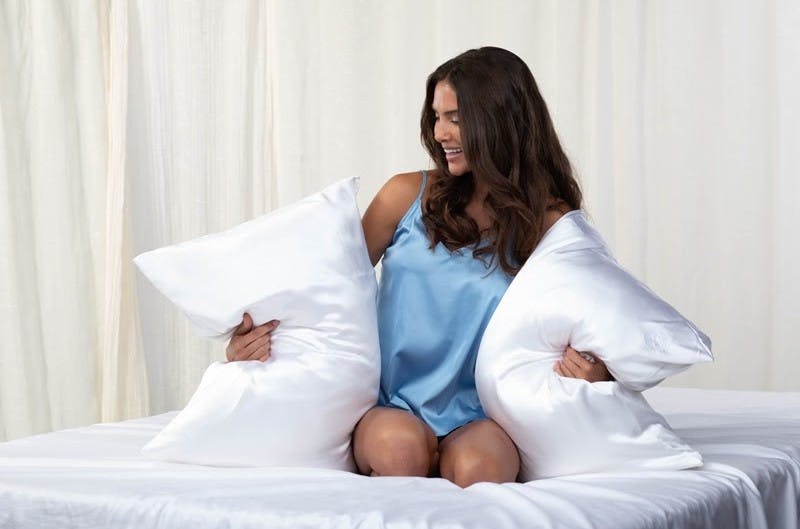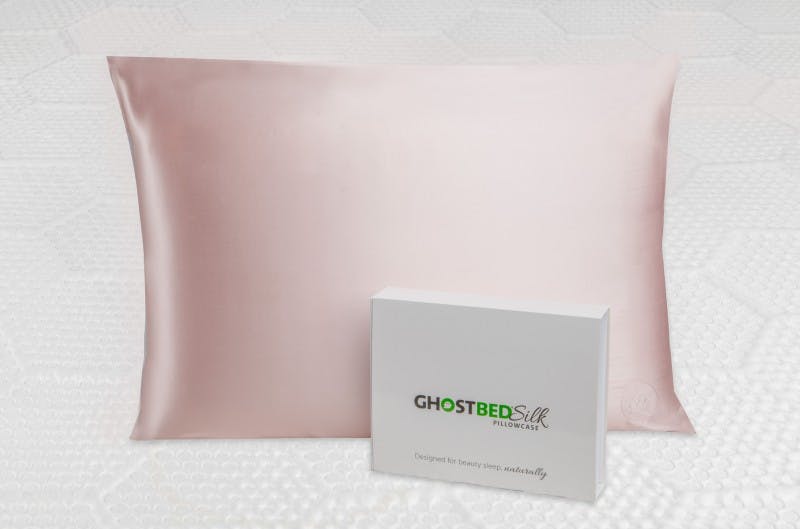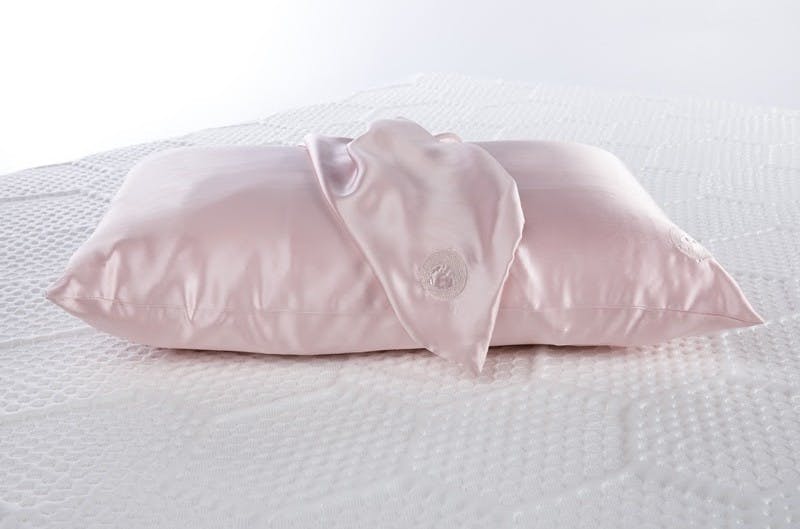The Ultimate Guide to Pillowcases
Last Updated on November 23, 2025
by Marc Werner, Founder - GhostBed
When it comes to bedroom style, your bedding can certainly set a mood. Comfortable sleep is the ultimate goal, but what if your pillowcase could do more than that? In this article, we’ll explore the different types of pillowcases you can choose from, and how to choose the best fabric and type for the most luxurious sleeping experience.

I. Comparing the Most Popular Pillowcase Types
II. Pillow & Pillowcase Styles
III. Pillowcase Fabrics
IV. Selecting Your Pillowcase
V. Compare GhostBed Silk
I. Comparing the Most Popular Pillowcase Types
Keep reading as we explore some of the most common types of pillowcases; for a quick overview, the chart below compares cotton, polyester, linen and silk pillowcases.
| Cotton | Polyester | Linen | Silk | |
|---|---|---|---|---|
| Benefits |
|
|
|
|
| Drawbacks |
|
|
|
|
Benefits
Cotton:
- Wide range of budget-friendly options
- Absorbs heat and moisture
Polyester:
- Wide range of budget-friendly options
- Easy to care for
Linen:
- Breathable and naturally cooling
- Antibacterial & hypoallergenic
Silk:
- Cool to the touch
- Provides a smooth surface for your skin and hair, reducing friction, creasing and tangling
Drawbacks
Cotton:
- Causes friction against skin and hair
- Large disparity in quality; cheaper cotton can deteriorate or pill over time
Polyester:
- Causes friction against skin and hair
- Large disparity in quality; cheaper polyester can pill over time
Linen:
- Very prone to wrinkling and pilling
- Can feel very rough
Silk:
- Pricier than other fabric options
- Requires special care & washing
II. Types of Pillow & Pillowcase Styles
Now, let’s explore some of the different pillowcase styles and terms you’ll come across. What you’ll need depends on the aesthetic you’re going after.
In the most basic and functional sense, you really only need one pillow per person. Depending on your sleeping style and comfort preferences, you can choose between a few different types of pillows, including those made of memory foam and faux down. (If you want to learn more about the different types, compare our pillows here!) You’ll then cover your pillow with a pillowcase to keep it clean and protect it from dirt and dander.
For extra style points, some people opt for extra pillows that are either layered, stacked or placed asymmetrically on the bed during the day. These could be throw pillows or accent pillows (typically smaller or a different shape, and come in a variety of textures and fabrics), or you can place a sham over another traditional pillow. A sham is a type of pillowcase that will typically match or complement your comforter, providing a decorative and polished look.
III. Pillowcase Fabrics
When you’re shopping for a normal pillow and pillowcase—i.e. what you’ll be sleeping on each night—the fabric you choose really does matter. After all, you’re spending all night with your face directly in contact with it!
The most common pillowcase types fall under one of 2 categories: natural and synthetic.
Natural: Cotton, Flannel, Bamboo, Linen, Silk
Natural fabrics, including cotton and linen, are very common for pillowcases. Cotton in particular is very soft and absorbent; in fact, it can absorb up to 25 times its weight in water! While this is a great feature for something like a bath towel, it’s not so great when it comes to your pillowcase. That’s because as your body loses water naturally as you sleep, it’s absorbed into your pillowcase and causes friction against your skin. The natural buildup from your sweat can also contribute to acne and other skin issues, and the rough texture of the fabric can leave your hair tangled and dry.
Similarly, flannel pillowcases are known for being soft and cozy for cold-weather sleeping. However, the rough fabric can trap excess oil and dirt and it’s known to pill over time, making it even rougher to sleep against.
Linen, bamboo and silk are much better options. Linen is known for its cooling properties, as is silk. Plus, silk pillowcases are ideal for your hair and skin, providing a smooth surface to help reduce facial creases and bedhead (among other benefits!). Because of these properties, silk is one of the best fabrics for pillowcases.
Synthetic: Nylon, Polyester
In the synthetic fabric category, we have nylon and polyester (aka microfiber). These fabrics are known to wick moisture—however, sometimes they can over-wick, which can also lead to dry skin and hair. They also don’t breathe very well, so dirt and sweat can get trapped within them. People with allergies, eczema and otherwise sensitive skin should also avoid synthetic fabrics, as they can be particularly irritating.
Velvet may also fall into this category, although it can be blended with natural fibers as well.
Satin vs. Silk
Wondering where satin falls? While many think satin and silk are synonymous, there’s actually a big difference.
Simply put, silk is a fiber, whereas satin is a type of weave. Meaning, your satin pillowcase is made from one or many different fabrics types, which could include a silk blend, nylon, rayon or polyester. If you’re looking for a cool, smooth feel—as well as the beauty benefits—you’ll want to look for a 100% silk pillowcase, instead of satin. A silk pillowcase will cost a bit more, and requires very special care when washing, but it’s well worth it.
IV. Selecting Your Pillowcase
With so many different types of pillowcases out there, how do you choose? And what about thread count—why aren’t we talking about that?
As for the second question, here’s the gist: whether you’re buying bedding or a pillowcase, thread count doesn’t actually matter. Thread count is simply the measure of horizontal (filling threads) and vertical (warp threads) threads that are in one-square-inch. But it’s not the best measure of quality. To better vet the quality of your bedding and pillowcases, focus on the fabric type.
GhostBed’s silk pillowcase, for example, is crafted with 100% Mulberry silk, known as the highest-quality silk available. Harvested from a specific type of domesticated silkworm, the controlled environment and conditions ensure that the silk produced is incredibly strong. Plus, its long fibers create a smooth surface that reflects light, offering a beautiful and luxurious look.

At the end of the day, you’ll want to choose a pillowcase that you enjoy sleeping on. A silk pillowcase goes above and beyond by providing extra benefits for your skin, hair and health, making it a great choice for anyone looking for top-of-the-line bedding.
V. Compare GhostBed Silk

How does GhostBed Silk compare to other silk pillowcases on the market? Check out the comparison chart below.
| GhostBed Silk | Blissy | Slip | |
|---|---|---|---|
| Price (Queen) | $99.95 | $89 | |
| Type of Silk | Mulberry | Mulberry | Mulberry |
| Momme (Weight) | 22mm | 22mm | 22mm |
| Warranty | 90 days |
|
|
| Free Shipping | Yes |
|
Orders over $500 |
| Free Shipping |
|
|
|
Marc has spent the last two decades designing & manufacturing mattresses and other sleep products, drawing on a lifetime of experience working with the material sciences. With several patents to his name, he works closely with the GhostBed team to create products with the perfect balance of comfort & support. Learn More

